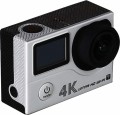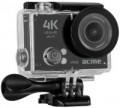Dust-, moisture-proof of case
The degree of dust and water protection of the protective case supplied with the camera.
Protected case will save your camera from dust, water, temperature changes, shocks, etc. The specific degree of protection is indicated according to the international IP (Ingress Protection Rating) system, according to which each device is assigned a code of the form IPXX, where X is replaced by specific numbers. The first of them characterizes the protection against the penetration of foreign objects (from 0 to 6, where 0 is no protection). Usually, in boxes for action cameras, this indicator does not go below 5, because otherwise the container would have too large gaps, and its use simply would not make sense. Level 5 provides dust resistance — dust can get inside the case, but in small quantities that do not affect the device inside. Level 6 corresponds to complete imperviousness to dust.
The second digit is protection against liquid ingress (from 0 to 8, where 0 is no protection). Usually, the minimum level of protection against water is 6.
6 — protection against short-term immersion (for example, falling into a sea wave);
7 — protection against temporary immersion under water (up to 30 minutes) to a shallow depth (up to 1 metre), without continuous operation in immersed mode;
8 — protection against immersion to a depth of more than 1 metre for a time of more than 30 m, with the possibility of continuous
...operation underwater. The specific level of protection of level 8 can be quite impressive — up to the possibility of diving to several tens of metres.
Note that protective cases for action cameras can be sold separately. Therefore, if the capabilities of the complete container do not suit you, there may be a more secure case on the market. On the other hand, in general, it is still more convenient to buy such an accessory immediately with a camera — so as not to waste time and effort on choosing the right protective case.HD (720p)
The ability of the camera to record HD video (720p).
The official HD specification provides a resolution of 1280x720. However, in action cameras, there may be resolutions slightly different from this parameter, for example, 1080x720 or 1440x960. Anyway, HD is the most modest of today's high-definition standards, which, nevertheless, provides a fairly clear and detailed image.
Another important parameter given in this paragraph is the frame rate. The higher it is, the smoother the movement in the frame will be, and the details in dynamic scenes will be visible clearly. Technically,
30 fps or even less is enough for video, but
60 fps is considered the perfect value — at this frame rate, motion blur becomes almost imperceptible and at the same time the size of the captured files remains within reasonable limits. However, there are cameras on the market with higher frame rates at HD resolutions —
100 fps,
120 fps,
200 fps and even
240 fps. This speed is usually used for recording slow-motion video, but such a possibility needs to be specified separately.
Field of view
For models with several lenses, as a rule, this parameter is indicated for each lens.
Most often (unless otherwise indicated), the specifications indicate the field of view by the diagonal of the frame; in some
ultra-wide-angle lenses it can exceed 180°. A special case is made up of lenses for which a 360° view is declared: this means that the optics cover the entire hemisphere in front of it. Such lenses are found in panoramic and 360-degree cameras (see “Product type”).
In general, the field of view primarily determines what area of the scene is being captured into the frame. Accordingly, the wider it is, the more space the camera captures, and the lower the likelihood that something that is happening will be off-screen. On the other hand, it is worth considering that a strong increase in the field of view leads to distortions of the “picture”, especially at the edges, as well as, to a decrease in the size of visible objects and a decrease in detail. Detailed recommendations regarding choosing a camera based on this parameter can be found in special sources.
Photo resolution
The maximum resolution at which the action camera can take photos. Specified in pixels horizontally and vertically.
This parameter is directly related to the resolution of the image sensor(see above): the total number of pixels in the photo, usually, corresponds to the number of pixels in the sensor. For example, a photo resolution of 4608x3456 corresponds to a sensor of 15925248 pixels, or approximately 16 megapixels. If the number of pixels in the photo is greater than the claimed resolution of the sensor, then the manufacturer uses software tricks that allow you to improve the photo resolution to a higher one than originally. This reduces the cost of devices but also affects the quality of images.
Theoretically, high-resolution images can provide good detail, but in fact, much depends on the specs of the sensor (primarily physical size) and image processing features.
Capabilities
—
Photo during video. The ability to take photos directly while recording a video — usually using a separate button. Thus, it is convenient to fix the most significant moments of what is happening. Such photos are much better in quality than "freeze frames" from the captured video.
—
Serial photo shoot. This feature allows you to take several pictures at once in a short period (usually it is a fraction of a second). A series of shots increases the chance of capturing a good moment, which can be very important given the specifics of using action cameras.
—
One click recording. The ability to quickly turn on the camera for recording — literally at the touch of a button, by the name. Moreover, such a button works even if the device is turned off. However, the recording inevitably starts with some delay; but often this delay is a fraction of a second.
—
Online streaming. Ability to stream video to popular services like YouTube and social networks (Facebook, Instagram, TikTok, etc.). Usually, the online streaming function is implemented when the action camera is connected to the Internet via a Wi-Fi network, less often via a wired connection. Communication with the World Wide Web can be held directly or through a smartphone or computer. It will require the use of appropriate software.
—
Time lapse. A special mode of operation of the action camera, in which video recording is carried out at a slower frequency is mainly used for filming slow processes. Thus, for example, a long journey or a long sunset can fit into a 3-minute video.
—
Auto-rotate. The function of automatic rotation of the captured photos and videos to the position corresponding to the position of the camera. Without this feature, all footage during playback would be displayed strictly in landscape orientation, and footage shot with the camera upside down or upside down would have to be rotated in a photo or video editor. Usually, at the beginning of video recording, auto-rotation is blocked — so that the position of the frame at any time corresponds to the rotation of the camera itself relative to its original position.
—
Photo panoramas shooting. The ability to use the camera to take panoramic photos. In traditional action cameras (see "Product type"), such shooting is carried out as follows: the camera takes several separate photos, which are then glued into one image. Regarding panoramic and 360-degree models (see ibid.), it is worth noting that not all such models support shooting in panoramic format, so it is advisable to check the availability of this function separately.
—
Key points labels. The ability to add special marks to the footage that indicate key moments. While viewing such videos, you can go directly to the labels — this is easier than manually searching for the right moment. This feature is especially useful when shooting long videos, as well as when numerous individual files. The label, usually, is placed right during the shooting by pressing a special button or by voice command.
—
Night shooting. Special mode for recording in low light conditions. The specific implementation of this function may be different: in some models, the sensitivity of the sensor is increased, in others, shooting in the IR range is used. Accordingly, specific features may vary: not every camera with this function can shoot in complete darkness, and these nuances should be clarified separately.
Display
— Diagonal. The larger the screen, the more convenient it is to watch (and also to control if the display is touch-sensitive). On the other hand, the diagonal of the
built-in display directly affects the size of the case, and action cameras should be quite compact. Thus, there are practically no screens larger than 2.5" in modern action cameras.
— Resolution. Theoretically, the higher the resolution, the clearer and better image the screen produces. On the other hand, displays in action cameras are designed mainly for menu operation and footage preview — and for these purposes, especially high resolutions are not needed. For models with two screens, the rear display is considered the main display.
— Touch screen. Display equipped with a sensor and responsive to touch like in smartphones/tablets. Control through such a display is simpler and more intuitive than using buttons, rotary knobs, etc. On the other hand, for more or less convenient control, the
touch screen must be quite large, which affects the dimensions of the entire camera.
Front screen
The presence in the camera of a screen mounted on the front panel, next to the lens. Other displays may not be present at all; in such cases, the diagonal, resolution and other parameters are given for
the front screen.
It is worth noting that most often the simplest black-and-white displays are installed on the front panel, suitable only for text and basic graphic information. However, even on such a screen, you can display a wide variety of service data: the current mode of operation (photo, video, standby), the resolution used, the shooting time, the amount of free space on the drive, etc. But more advanced displays are not used as front displays: a full-colour screen is needed only for taking a selfie, and for this you can use a
remote display with a remote control(see "Control") or a smartphone connected to the camera.
Speaker
Speaker or speakers installed directly in the camera body. This function is mainly intended to allow you to view footage with sound without connecting headphones or external speakers. However the
built-in speakers do not have decent volume or general sound quality — nevertheless, they allow you to determine what the camera “heard” as a whole, whether sound recording was turned on, whether individual ambient sounds got into the recording, etc.
Mobile app
The mobile app for action cameras provides a convenient way to control the device and expand its functionality. With such an app, you can remotely start and stop recording, adjust camera settings, and more. Additionally, the app allows you to view recorded footage and transfer it to a mobile device for further editing or sharing via social networks. The ability to view in real-time from the action camera through a smartphone allows for precise frame adjustments and monitoring of the shooting process. Many apps also offer basic tools for content editing, adding effects and music, making the process of creating and publishing videos even more convenient and accessible.

